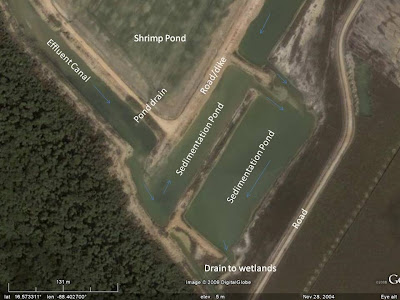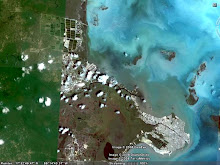Friday, January 30, 2009
More context
The following links are provided to help set the framework for understanding the social setting for aquaculture. There are important facts here that everyone should learn. Be warned, however, that these web sites all tell the truth from their own perspective. Some information is outdated. Some is biased. As you read, be good scientists. Think objectively. Be skeptical. Look for alternative hypotheses and weigh the information you're given with the best data and evidence you can find.
Hopefully these links and other information will give you a sense of the historical nature of the aquaculture industry. Here in Illinois, we live in a landscape transformed by agriculture, a process that began 10,000 years ago. In our lifetimes, the sea is being transformed in the same way. The traditional hunter-gatherer fisheries capturing wild animals for food is giving way to aquaculture.
The unique difference between cultivated foods on the land and the sea is that aquaculture is occurring in a context where science, vastly superior technology, and an awareness of the need conserve and protect natural resources can guide its’ development from the outset. Just as terrestrial agriculture transformed humans and made civilization possible, aquaculture creates resources that have significant potential to alter not only human history, but the natural history of the planet.
Welcome to your part in an historical process.
Aquaculture organizations and news sources
https://www.was.org/Main/Default.asp
http://www.gaalliance.org/
http://www.shrimpnews.com/
Belizean shrimp aquaculture links
http://www.worldwildlife.org/what/globalmarkets/agriculture/ridgetoreef.html
http://www.worldwildlife.org/what/globalmarkets/aquaculture/grandma.html
http://www.balshrimp.com/
http://www.fao.org/fishery/countrysector/naso_belize
Belizean history, culture, language, newspapers and environment
http://www.kriol.org.bz/index.htm
http://www.amandala.com.bz/
http://healthyreefs.org/
http://www.worldwildlife.org/what/wherewework/mesoamericanreef/
2006 Slate article regarding shrimp aquaculture
http://www.slate.com/id/2134219/
Shrimp aquaculture ecocertification dialogues
http://www.worldwildlife.org/what/globalmarkets/aquaculture/WWFBinaryitem8614.pdf
http://www.worldwildlife.org/what/globalmarkets/aquaculture/dialogues-shrimp.html
Environmental critics of shrimp farming
http://www.worldwatch.org/node/1500
http://www.mindfully.org/Water/2004/Aquaculture-Blue-RevolutionJan04.htm
http://www.mangroveactionproject.org/
Friday, January 23, 2009
Basic info. and (shrimp) food for thought
I had some conversations with contacts in Belize yesterday. It appears we'll be hearing from Independence High School within a couple of weeks.
In the meantime, I'm going to begin posting a few bits of basic information and web links that we can use to help us begin thinking about the project.
Again, the basic goal of the project is to design a substrate that can be deployed in shrimp pond waste effluent canals, colonized by aquatic organisms (especially algae and bacteria) and stripped to feed shrimp. This process uses waste effluent nutrients to create a healthy, cost-effective economic resource. To be sustainble and useful, the whole process needs to have minimal materials and labor costs and needs to provide the maximum possible amount of healthy food for cultured shrimp and the maxiumum possible nutrient removal from effluents.
We will eventually need to make decisions about what substrates to use, how to deploy them, how often to deploy them, how to retrieve them,
One substrate we can use is the Aquamat. Here is a web page that has pictures of Aquamats and discusses how they work.
http://www.nurturetech.net/aqua.htm
Notice in the text that Aquamats fix (grow) between 1.3 to 0.5 g/m of nitrogen every day Phosphorus uptake will be between 25-30 mg/m/day. Most of that growth will be in the form of algae and bacteria that are desirable food items for shrimp.
For a conservative rule of thumb, let's assume we can grow about 1 gram of N per day and 0.05 g/P per day on each Aquamat.
That is enough N and P to improve water quality around the farms if..
1. Enough Aquamats are in place
2. The organisms growing on them can actually be effectively removed from the effluent canals and sedimentation ponds.
That material will be useful as feed for the farmers if….
1. The labor cost of stripping food organisms from the mats is less than the cost of feed and feeding
2. The “food” organisms promote healthy growth of the shrimp equal to or greater than the cost of similar production.
If we can devise an effective system that meets these goals we can improve both the environmental and economic sustainability of shrimp farming in Belize.
Saturday, January 17, 2009
Good meeting yesterday
If you're just coming to the site, I encourage you to read the previous posts and post questions and comments. I monitor the site frequently and you'll get an answer to your question within a day or so.
In the meantime, I'll be working to get our partners ready to go and provide technical information to help us all start thinking about what kind of materials and substrates we should be thinking about as a periphtyon substrate in Belizean shrimp pond effluents.
Watch the web site too for posts from visitors. Several people have expressed an interest in our project and it will be great for us to hear their perspectives on what we are planning to do.
Monday, January 5, 2009

Water carrying high levels of nutrient from the shrimp pond (upper middle) is released through a drainage structure into an effluent canal. The effluent canal carries the water to sedimentation ponds where some of the nutrient settles out to the bottom of the pond, enters the food chain or is released into the atmosphere through de-nitrification. During the final step of treatment, the water flows from the sedimentation pond into a natural wetland mostly full of red mangrove. After that, it then enters a tidal creek and then flows to the sea where it eventually dilutes to become equivalent to background levels. The size of these canals varies. They are usually longer than a kilomter from 2 to 50 meters wide with a depth from 1.8 meters to less than one meter in depth.
The overall short-term goal is to reduce the amount of nutrient (primarily nitrogen and phosphorus in all forms) exiting the sedimentation pond and entering the natural wetland.
The Inventors Club project will be to design a substrate that can be placed in these effluent canals, colonized by algae, biofilms and biofouling organisms, and then stripped to feed the shrimp growing in the ponds nearby.



